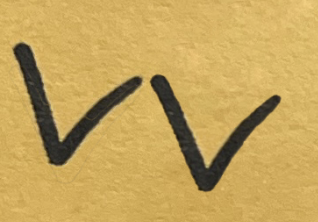WWWWW
/At the end of February, I had something happen to me twice that I don’t remember ever happening before. I dreamt of a new magic trick. I spend a lot of my waking hours thinking about magic, but it rarely creeps into my subconscious. The interesting thing is that these tricks were not terrible.
One of the tricks was a Shuffle-Bored presentation that I’m going to try out and report back on in some form.
The other was the trick that follows. I’ll be honest, it’s not a good trick. It’s just not a terrible trick.
In the dream, I was performing for Tiffani-Amber Thiessen…
We were on a bridge high above the clouds…
There was also something having to do with Russia and filming a practical joke TV show. But I don’t quite remember those details.
Dream
In the dream, I brought out an envelope. There were 5 Ws written on the back of the envelope.
I pulled out two cards from the envelope. The King of Spades and the 8 of Hearts.
“I’ve been playing this game with someone every day for the past few days. I never lose. And when I win, I add another ‘W’ to the back of the envelope.”
I explained how the game is played. It’s a best-of-seven contest. I will put the two cards behind my back and bring one of them out face-down. Tiffani has to try and guess the card that’s behind my back. If she gets it wrong, I win that round. If she gets it right, I lose that round.
We play the game and I win the first round.
Then I lose the second round and the third.
I pause to recap. “So I won the first round but lost the second and third. So I’m down 2 to 1.”
I win round four and round five.
I pause again. “So it went Win-Lose-Lose-Win-Win, yes? 3-2 me. I’m just one win away from winning the best-of-seven contest.”
Unfortunately, I lose the next round.
It’s all tied up and comes to the final round. Which I lose.
I recap. I lost the match 4-3. I won the first round, lost the next two, won the next two, and then lost the final two. W-L-L-W-W-L-L
“I told you, I never lose!” I tell Tiffani.
“What are you talking about? You just lost.”
“What… that? The guessing part? Oh, that’s not how you win the game.” I turn the envelope around and on the other side it says,
You win the game by correctly predicting the outcome of each round.
“That’s what I did,” I tell her. “I predicted I’d win the first round, then lose two. Then I’d come back to take the lead by winning the next two rounds. Then I’d lose the final two. Win-Lose-Lose-Win-Win-Lose-Lose.”
“Where did you predict this?” she asked.
“What are you talking about? I showed it to you before we started. You were looking at it the whole time.”
I turn the envelope back around and show her the 5 Ws on the other side.
When you look at them, two of them aren’t quite Ws. The lines aren’t connected. They’re two crooked Ls.
W-L-L-W-W-L-L
Win-Lose-Lose-Win-Win-Lose-Lose
I pull out a Sharpie and add another W to the back of the envelope.
Method
Look, for a trick from a dream, it’s not that bad. I’ve seen dumber shit in magic magazines.
Although I admit I don’t know how powerful an effect that is predicated on a missing half-millimeter of ink is.
I think if I was to actually do this I would reiterate the prediction on a piece of paper inside the envelope. So if they seemed dubious that the back of my envelope was really my “prediction,” I could have them reach into the envelope and remove a prediction that said clearly.
I will make you win 4-3 in the following manner.
1st Round - I win
2nd Round - I lose
3rd Round - I lose
4th Round - I win
5th Round - I win
6th Round - I lose
7th Round - I lose
Similar to the brilliant trick, Silver Linings, by Jack Curtis from his Distorted Visions release. (If you need some strong, easy, straightforward mentalism effects, buy Distorted Visions.)
How do you force the outcome of the game?
With a trick I bought on my first ever trick to a magic shop: Two Card Monte (the original version, not the Blaine one). A double-backer and a double facer are held together in your hand. You turn your wrist to show two different cards while sliding the cards across each other. It’s a discrepant display, but it usually flies.
You place them behind your back and bring out the double-backer. Then you pull out the double-facer in the correct orientation to make them win or lose.
Of course, you could do the same thing with any simple trick where you can force the outcome.
I don’t know that I’ll ever actually try this out other than in my dream. I can see it being sort of amusing and it’s simple enough to carry it around with you in your wallet if you’re so inclined. If any of you give it a shot, let me know how it goes.
Also, if you know of any trick that uses the W - Two Ls lookalike thing, let me know. I’m curious if my dream mind pulled it from something I read somewhere or if it actually came from my subconscious.
















